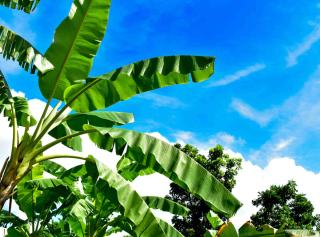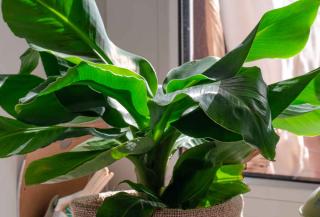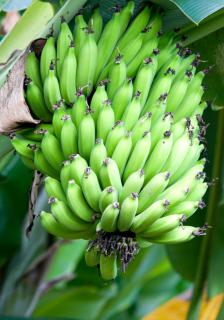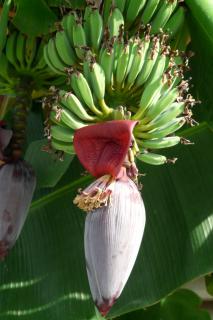

Considered the largest grass on earth, the banana tree is a very interesting tropical plant that can be grown even in non-tropical areas if a few precautions are taken.
Basic Banana tree facts
Name – Musa
Type – herbaceous plant
Height – 3 to 23 feet (1 to 7 meters) depending on the variety and the climate
Exposure – very well-lit
Soil – soil mix
Foliage – evergreen or deciduous depending on the climate
The banana tree requires good soil mix that can be amended with ⅓ compost, if you’ve got any.
In order to enhance drainage, pour clay pebbles or small stones into the pot to form a layer at the bottom.
T
Just as might be done in pots, feel free to place a bed of gravel, small stones or clay pebbles to ensure proper drainage.
Generally speaking, the banana tree can’t cope with the winter cold, it tends to lose its leaves when temperatures drop below 35°F (2°C), and it will need to be protected in winter.
However the airborne parts fare, it should grow back in the following spring because its root system is much more hardy and can survive down to -2° F (-19°C). Tropical banana trees will die if temperatures drop below 50°F (10°C), and they can only be grown in greenhouses.
The ideal setting faces towards the equator, along a wall that shelters it from wind.

It grows best when surrounding temperatures hold around 65 to 72°F (18 to 22°C) and requires very good light, but not direct sunlight.
Behind a window, best avoid too much direct exposure to the sun which might dry your banana tree up.
Best place it near a window facing to the West so that it would still have a good deal of light.
If you live in a house that is quite dark, avoid purchasing a banana tree because it won’t cope well with the lack of luminosity.
Indoors, it is important to mist water on the leaves regularly to recreate its natural living conditions which are rather moist.
For strong growth and magnificent leafage, you can add leaf plant fertilizer.
This is usually the time of the year when the banana tree grows most.
For potted banana trees, water regularly while letting the soil mix dry at the surface before watering again.
When outdoors, watering must be regular but limited, in order to not suffocate the plant’s roots.
You might say that watering every 2 or 3 days is often needed, especially when the heat rises.
More or less every two weeks, you can offer it some liquid fertilizer, taking great care to moisten the soil mix beforehand.
Start reducing the watering because the plant’s water needs begin to decrease.
Only when the soil is dry down to the first inch or so (a couple centimeters), water to moisten the entire soil mix clump again.
Finally, this season is also the one to stop adding fertilizer, from October all the way to March and April.

For Europe, bananas mainly come from 4 parts of the world: Guadeloupe, Martinique, the Canary Islands and Madeira.
As for the rest of the world, production mostly comes from India, Brazil, and South American countries.
If you want to succeed in harvesting bananas in an indoor greenhouse, you’ll need to recreate the tropical conditions of its native environment:

Although subtropical banana varieties can grow in our climates, tropical banana trees are prone to freezing and can thus only be grown in greenhouses, winter gardens and indoors.
Both appealing to the eye and very easy to grow, it is among the most liked indoor plants for houses and apartments.
Its foliage is particularly elegant and brings a touch of exotic life to a living room, dining area, or any other room of the house that is well-lit.
Banana is a fruit with a high calorie count which makes it very interesting for athletes.
It has high sugar contents like starch and carbohydrates.
If well cared for, your banana tree will resist diseases and parasites well.
But if you discover something unusual, feel free to ask a question on our forum to quickly get an answer.